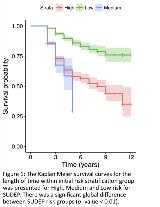Longitudinal SUDEP Risk Stratification With Electronic Diaries
Abstract number :
2.158
Submission category :
4. Clinical Epilepsy / 4D. Prognosis
Year :
2018
Submission ID :
501567
Source :
www.aesnet.org
Presentation date :
12/2/2018 4:04:48 PM
Published date :
Nov 5, 2018, 18:00 PM
Authors :
Neishay Ayub, Beth Israel Deaconess Medical Center; Sharon Chiang, University of California - San Francisco; Robert Moss, SeizureTracker LLC; and Daniel M. Goldenholz, Beth Israel Deaconess Medical Center
Rationale: Sudden Unexplained Death in Epilepsy (SUDEP) is poorly understood, but it is a significant contributor of epilepsy deaths each year. In Harden et al (2017), the following risk factors have been identified with class B evidence: presence of GTC, frequency of GTCs, absence of seizure freedom. These risk factors have not systematically been personalized for an individual’s risk for SUDEP, nor has it been seen if an individual’s risk of SUDEP changes over time. SeizureTracker.com is a large scale patient reported database that serves as an online and mobile seizure diary. This study aims to stratify this patient data into high, medium and low risk for SUDEP based on previously identified risk factors and monitor how this changes over time. Methods: From December 2007 to February 2018, seizures were collected from 12,402 users, within inclusion and exclusion criteria. Over 1.4 million seizures were analyzed and further grouped into generalized (defined as “ tonic clonic” or “secondarily generalized”) and other seizures. The number of generalized seizures for each year since the initial seizure diary entry was calculated for each user and each year given a designation of low, medium or high risk for SUDEP: Low (0 generalized seizures in a year), Medium (1-2 generalized seizures in a year), and High (> 3 generalized seizures in a year). Survival analysis was used to assess the probability of SUDEP risk diverging from the initial risk stratification. The log-rank test was used to compare user groups originally presenting with High, Medium, or Low SUDEP risk. Analysis was completed with Tableau and R. Results: The primary endpoint was the length of time within initial risk stratification group. The Kaplan Meier survival curves for the length of time within initial risk stratification group was presented for High, Medium and Low risk for SUDEP (Figure 1). There was a significant global difference between SUDEP risk groups (p -value < 0.01). Further pairwise log rank tests revealed no significant difference between High and Medium risk groups (p-value = 0.09). There was a significant difference between High and Low risk groups (p-value < 0.01) as well as Medium and Low risk groups (p-value < 0.01) respectively. Conclusions: The vast majority of the patients who began with a low risk of SUDEP remained in this categorization, whereas the patients who began in Medium or High risk for SUDEP left this initial categorization, either by changing risk groups or discontinuation of app use. After three years of tracking seizures, approximately 30% of patients in the High and Medium Risk for SUDEP left their initial risk group, while 7% of patients in Low Risk for SUDEP left their initial risk group. This study can be helpful in counseling patients regarding their risk factors for SUDEP and how it can change over time.ReferenceHarden C, Tomson T, Gloss D, Buchhalter J, Cross JH, Donner E, French JA, Gil-Nagel A, Hesdorffer DC, Smithson WH, Spitz MC, Walczak TS, Sander JW, Ryvlin P. Practice guideline summary: Sudden unexpected death in epilepsy incidence rates and risk factors: Report of the Guideline Development, Dissemination, and Implementation Subcommittee of the American Academy of Neurology and the American Epilepsy Society. Neurology. 2017 Apr 25;88(17):1674-1680. doi: 10.1212/WNL.0000000000003685 Funding: T32NS048005, Harvard TH Chan School of Public HealthBetensky (PI), 03/01/18-02/28/19Neurostatistics and Neuroepidemiology Fellowship
